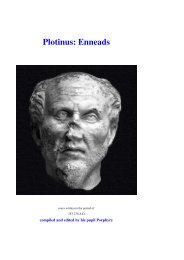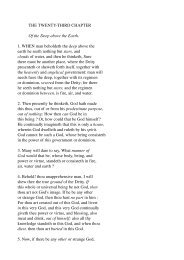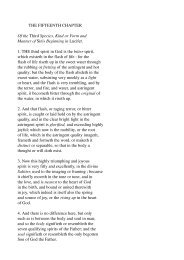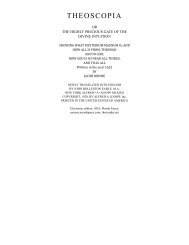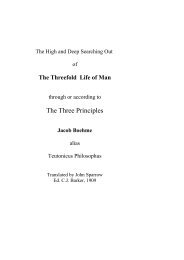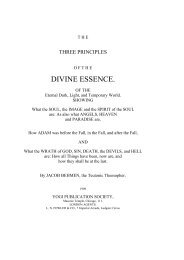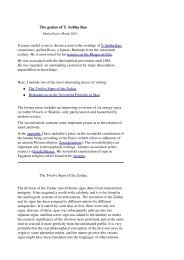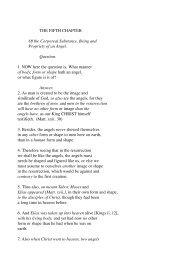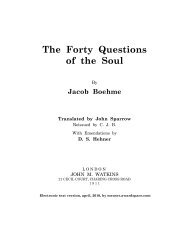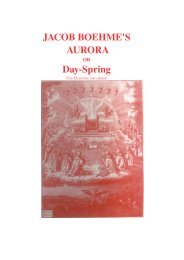Gerald Massey's Lectures - Society in evolution - Awardspace
Gerald Massey's Lectures - Society in evolution - Awardspace
Gerald Massey's Lectures - Society in evolution - Awardspace
You also want an ePaper? Increase the reach of your titles
YUMPU automatically turns print PDFs into web optimized ePapers that Google loves.
entered <strong>in</strong>to him." Then said Jesus to him <strong>in</strong>to whom the evil or devil had been<br />
transported, "That thou doest, do quickly." Osiris was the same, beseech<strong>in</strong>g burial. Here<br />
it is demonstrable that the non-historical Herod is a form of the Apophis Serpent, called<br />
the enemy of the Sun. In Syriac, Herod is a red dragon. Herod, <strong>in</strong> Hebrew, signifies a<br />
terror. Heru (Eg.) is to terrify, and Herrut (Eg.) is the Snake, the typical reptile. The blood<br />
of the div<strong>in</strong>e victim that is poured forth by the Apophis Serpent at the sixth hour, on "the<br />
night of smit<strong>in</strong>g the profane," is literally shed by Herod, as the Herrut or Typhonian<br />
Serpent.<br />
The speaker, <strong>in</strong> the Ritual asks: "Who art thou then, Lord of the Silent Body? I have<br />
come to see him who is <strong>in</strong> the serpent, eye to eye, and face to face." "Lord of the Silent<br />
Body" is a title of the Osiris. "Who art thou then, Lord of the Silent Body?" is asked and<br />
left unanswered. This character is also assigned to the Christ. The High Priest said unto<br />
him, "Answerest thou noth<strong>in</strong>g?" "But Jesus held his peace." Herod questioned him <strong>in</strong><br />
many words, but he answered him noth<strong>in</strong>g. He acts the prescribed character of "Lord of<br />
the Silent Body."<br />
The transaction <strong>in</strong> the sixth hour of the night of the Crucifixion is expressly <strong>in</strong>explicable.<br />
In the Gospel we read:--"Now from the sixth hour there was darkness over all the land<br />
unto the n<strong>in</strong>th hour." The sixth hour be<strong>in</strong>g midnight, that shows the solar nature of the<br />
mystery, which has been transferred to the sixth hour of the day <strong>in</strong> the Gospel.<br />
It is <strong>in</strong> the seventh hour the mortal struggle takes place between the Osiris and the deadly<br />
Apophis, or the great serpent, Haber, 450 cubits long, that fills the whole heaven with its<br />
vast envelop<strong>in</strong>g folds. The name of this seventh hour is "that which wounds the serpent<br />
Haber." In this conflict with the evil power thus portrayed the Sun-God is designated the<br />
"Conqueror of the Grave," and is said to make his advance through the <strong>in</strong>fluence of Isis,<br />
who aids him <strong>in</strong> repell<strong>in</strong>g the serpent or devil of darkness. In the Gospel, Christ is<br />
likewise set forth <strong>in</strong> the supreme struggle as "Conqueror of the Grave," for "the graves<br />
were opened, and many bodies of the sa<strong>in</strong>ts which slept arose;" and Mary represents Isis,<br />
the mother, at the cross. It is said of the great serpent, "There are those on earth who do<br />
not dr<strong>in</strong>k of the waters of this serpent, Haber," which may be paralleled with the refusal<br />
of the Christ to dr<strong>in</strong>k of the v<strong>in</strong>egar m<strong>in</strong>gled with gall.<br />
When the God has overcome the Apophis Serpent, his old nightly, annual, and eternal<br />
enemy, he exclaims, "I come! I have made my way! I have come like the sun, through the<br />
gate of the one who likes to deceive and destroy, otherwise called the 'viper.' I have made<br />
my way! I have bruised the serpent, I have passed."<br />
But the more express representation <strong>in</strong> the mysteries was that of the annual sun as the<br />
Elder Horus, or Atum. As Julius Firmicus says: "In the solemn celebration of the<br />
mysteries, all th<strong>in</strong>gs <strong>in</strong> order had to be done which the youth either did or suffered <strong>in</strong> his<br />
death."<br />
Diodorus Siculus rightly identified the "whole fable of the underworld," that was<br />
dramatised <strong>in</strong> Greece, as hav<strong>in</strong>g been copied "from the ceremonies of the Egyptian<br />
funerals," and so brought on from Egypt <strong>in</strong>to Greece and Rome. One part of this mystery<br />
was the portrayal of the suffer<strong>in</strong>g Sun-God <strong>in</strong> a fem<strong>in</strong><strong>in</strong>e phase. When the suffer<strong>in</strong>g sun<br />
was ail<strong>in</strong>g and ill, he became female, such be<strong>in</strong>g a primitive mode of expression. Luke<br />
describes the Lord <strong>in</strong> the Garden of Gethsemane as be<strong>in</strong>g <strong>in</strong> a great agony, "and his sweat<br />
was, as it were, great drops of blood fall<strong>in</strong>g to the ground." This experience the Gnostics<br />
identified with the suffer<strong>in</strong>g of their own hemorrhoidal Sophia, whose passion is the<br />
orig<strong>in</strong>al of that which is celebrated dur<strong>in</strong>g Passion week, the "week of weep<strong>in</strong>g <strong>in</strong> Abtu,"<br />
and which constitutes the fundamental mystery of the Rosy Cross, and the Rose of<br />
Silence.<br />
In this agony and bloody sweat the Christ simply fulfils the character of Osiris Tesh-<br />
Tesh, the red sun, the Sun-God that suffers his agony and bloody sweat <strong>in</strong> Smen, whence<br />
Gethsmen, or Gethsemane. Tesh means the bleed<strong>in</strong>g, red, gory, separate, cut, and



